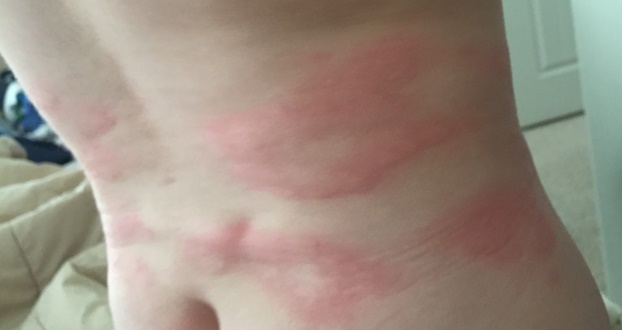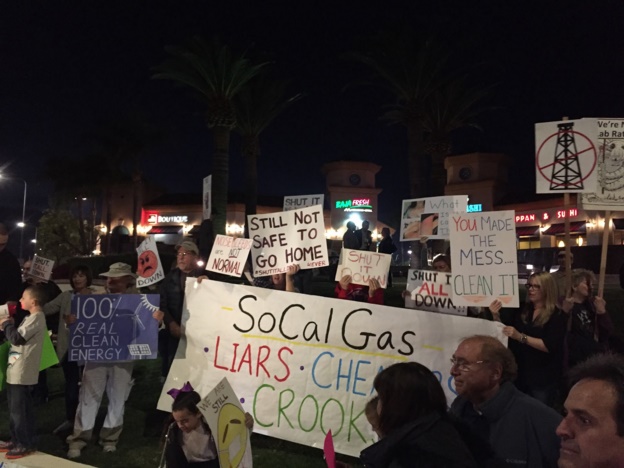Carey Wedler
March 25, 2016
(ANTIMEDIA) Porter Ranch, CA — On February 18, SoCalGas and the national media declared the “worst methane gas leak in U.S. history” permanently sealed, but just over a month later, hundreds of Porter Ranch residents who evacuated — and are now returning home — are suffering the same symptoms they suffered when the gas leak was active. They are experiencing nausea, dizziness, fatigue, headaches, nosebleeds, and many, including children, are also experiencing a new ailment: irritated skin rashes across their bodies.
Neither SoCalGas, which owns the Aliso Canyon facility, the Los Angeles County Department of Public Health, nor any other government agency has provided a concrete explanation for these continued symptoms. In fact, one of Los Angeles County’s top medical officials recently told local physicians to refrain from performing tests to determine what is causing the symptoms. Late last week, preliminary lab tests from an independent UCLA study found evidence of benzene, a carcinogen, in at least two Porter Ranch homes. Benzene was reported to have been released in the 100 metric tons of methane that spewed into the Los Angeles basin for four months — a fact SoCalGas previously attempted to downplay and withhold.
Reemergence of Symptoms
On March 4, Los Angeles City Councilmember Mitchell Englander issued a press release reporting the Department of Public Health had received at least 150 complaints of reemerging symptoms, including nosebleeds, dizziness headaches, nausea, and skin rashes. Now, the Health Department says it has received 300 complaints since residents began moving home after SoCalGas told them it was safe to do so.
Many residents have said the rashes, which can be extensive, are new and did not occur during the initial, months-long gas leak from October to February. During that time, thousands of families were evacuated and the Department of Public Health received 700 health complaints. Others reported experiencing skin irritation before they relocated, though it appears to be more widespread now.
Residents who left Porter Ranch for temporary housing accommodations and recently moved home told Anti-Media about their symptoms (many still have not moved home, fearful it is still unsafe). Helen Ritenour, a Porter Ranch resident who left the area in December, said that within two days of returning to their home, she and her family began feeling sick.
“The main symptoms are headaches, difficulty breathing, watery eyes, coughing and general fatigue. It feels like I’m in a thick fog of sorts that’s oppressive,” she said. She and her husband were not eager to return home, still concerned about toxins in the area and the health of their newborn baby. But amid long delays receiving reimbursements from SoCalGas — and unable to charge more expenses on their credit card — they moved back to Porter Ranch. Ritenour told Anti-Media that like many other families, she and her husband have had to pay out-of-pocket for relocation services — and have experienced long delays receiving reimbursement checks.
Gabriel Khanlian, a resident who serves as the Chief Technology Officer for Save Porter Ranch, a group formed in 2014 to fight the massive, aging, and leaking facility before the blowout even happened, also said he and his family have suffered symptoms since moving home.
“My daughter Tatiana keeps getting large rashes, red welts and bumps all over her body. Her skin is dry and her behavior has changed significantly and she is very cranky. She has a loss of appetite and is sleeping a lot more,” he said. “My sons, Jayden and Mason, have been getting bloody noses, headaches, upset stomachs, burning eyes, runny nose, dry skin.”
He described other troubles they’ve had, noting his sons are experiencing “anxiety, fear, frustration, anger, and stress from not having the ability to play. Their personalities have changed majorly.”
He said his wife, who experienced symptoms during the initial methane gas leak, is now experiencing them more severely than before.
Kyoko Habino, a Porter Ranch resident and co-founder of Save Porter Ranch, said:
“When I go home to pick up stuff or do a few things, within a few minutes, I start having a dull headache and coughing and having palpitations. Nosebleeds follow later on often. My partner has had headaches, fatigue, and a burning sensation in his chest at the same time I have. Our cat has had a nosebleed and vomited. When I am away from home, the headache goes away instantly. The cough and nosebleed stay for a while, and are gone after.”
Walter Arwood, a Porter Ranch resident, experienced nausea, among other symptoms:
“I am rolling over sick right now. My stomach has been so upset, I have gotten all the headaches back, my husband has had three nose bleeds in two days, and now a visiting relative was out of breath just walking up the stairs at my home. How is it safe?”
Arwood was evacuated during the methane gas leak and recently returned home. “Since we have moved back the symptoms have immediately returned,” he said. “Itchy skin is the only new thing. We have all of our air purifiers on and the scrubber running and still it is happening.”
Residents in surrounding areas, including Chatsworth and Granada Hills, have also reported a reemergence of symptoms.
Sandy Crawford, a resident of Granada Hills, told CBS News in February — after the methane gas leak was sealed — that within a few hours of returning home, her youngest son had trouble breathing and suffered a nosebleed. Crawford moved her sons back to their hotel, and after trying again to move home and experiencing the same results, she returned to the hotel for a second time. She told Anti-Media they recently tried sleeping at home for a few nights and did not feel symptoms, but she remains afraid they could return. As a result, she is staying at the hotel.
“Avoid performing any toxicological tests”
Though these symptoms are pronounced, neither SoCalGas nor the Department of Public Health has offered a definitive explanation of what is causing them. In fact, Dr. Cyrus Rangan, Director of the Bureau of Toxicology and Environmental Assessment at the Los Angeles County Department of Public Health, recently issued a “Health Update” to “primary care, urgent care, internal medicine, and emergency medicine providers” in the area cautioning them against conducting tests on patients with symptoms.
The advisory, dated Tuesday, March 8, requested that healthcare professionals “look for alternate etiologies other than air contamination,” and “avoid performing any toxicological tests,” claiming “these are not recommended and are unlikely to provide useful data for clinical evaluation of patients.”
Rangan said in the notice that if no “alternative etiology” is found, doctors should consult with him. While it is an indisputable act of due diligence to recommend doctors check for other potential causes of symptoms, it is unclear why a top public health official would discourage doctors from performing tests to better understand illnesses among their patients.
“It’s not to steer the community away from thinking it’s not an environmental issue,” Rangan insisted to the Los Angeles Daily News, adding that, as the local paper summarized, “even when the gas was leaking he did not recommend that doctors perform toxicological tests because there is no test that can determine if a person was exposed to natural gas.”
However, residents are concerned not just with methane, but with other contaminants found in it, from mercaptans to benzene to other toxic emissions (mercaptans are odorants added to natural gas to make it detectable, and are believed to have caused symptoms when the gas leak was active). Many found Rangan’s explanation to be insufficient and an attempt to ask doctors to “look the other way.”
Further, his request that doctors refrain from conducting tests appears to contradict his own supplementary declaration provided for a hearing held last Friday to extend relocation benefits to residents, many of whom feel they were rushed out of temporary housing, evidently, before it was safe to return home.
In that statement, Rangan referred to the continued illnesses as “perplexing,” proceeding to offer potential explanations not previously disclosed to Anti-Media when he spoke with us:
“It could be that there are persistent levels of contaminants still present in the community, or there could be other exposures in areas of the community that were missed in the external environmental monitoring, or perhaps gases may have saturated the soil at the Aliso Canyon facility or other substrates and are being released now that the source has been sealed.”
In spite of Rangan’s multiple hypotheses, however, he has offered no definitive explanation, nor does it appear the Department of Public Health has seriously looked for one (meaning it could be helpful for physicians to run tests on their patients). Asked to investigate a persistent oily residue coating the outside of residents’ homes and the playground of at least one park, representatives sent from Public Health reported they found “no evidence of any oily residue and no health concern for residents or visitors.”
When residents complained to Councilman Englander, representatives from his office confirmed the playsets were coated in oil and SoCalGas agreed clean the park. Three other parks were also shut down amid concerns about the residue, which Rangan insists is safe, aside from causing skin irritation. Mandi Bane, a lab assistant in Rangan’s office, told Anti-Media they have no intentions to test the soil in the community.
Because of incidents like this — such as Dr. Rangan downplaying concerns about long-term side effects from mercaptans, though there is little research to support his assurances — some residents increasingly doubt Public Health’s commitment to helping the community. Many have complained they reported symptoms and received little more than packaged statements in response. Some received no response.
Rangan’s office did conduct door-to-door surveys of residents two weeks ago to gather information on what could be causing the symptoms, an effort reported to be joined by state officials. Bane told Anti-Media they recorded over 200 reports and it would take time to process them before they could comment.
Rangan’s office also requested outside assistance to conduct indoor air sampling, after it was “determined that such a protocol is beyond the expertise of the Department of Public Health.”
Rangan first solicited the help of the EPA to conduct indoor air testing for contaminants, but it was expected to take until May to develop a protocol. Last week, however, Dr. Michael Jerrett, a professor and chairman of UCLA’s Fielding School of Public Health, shared preliminary test results from a small sample of homes with Public Health. The independent study raised concerns about the presence of benzene, a known carcinogen, as well as hexane, in two homes. As a result of these findings, UCLA has partnered with Public Health and Dr. Jerrett and his team will begin sampling 120 homes in the coming days to conduct further analysis. According to a press release from the Department of Public Health posted Saturday:
“As a continuation of Professor Jerrett’s independent study, an indoor dust swab sampling was completed in seven homes. Benzene and hexane were found in two of the homes. Benzene and hexane, at certain levels, have known toxic effects on humans, but it is unknown whether the levels found are high enough to be of health concern. Professor Jerrett is sharing these findings with the community and will continue to conduct independent scientific analyses.”
As the Daily News explained, Jerrett’s results showed “higher and more variable concentrations of particulate matter in the outdoor air at locations close to the leak site compared to those farther away, according to the Health Department. Particulate matter is described as tiny pieces of solids or liquids in the air, such as dust, dirt, soot, or drops which can irritate the skin, eyes, nose, throat, respiratory, and cardiovascular systems.”
SoCalGas, however, has failed to provide a conclusive explanation for residents’ illnesses. At a protest on Friday, March 4, which culminated outside the company’s Community Resource Center located in Porter Ranch’s main shopping center, SoCalGas spokeswoman Lisa Alexander spoke to Anti-Media about the reemergence of symptoms. She left the onus of responsibility on the Department of Public Health.
“You know, we recognize that people are saying that they have symptoms, and we hear that, we see the news stories, we’ve been in touch with Department of Public Health to inquire about that,” she said, adding that Public Health expected symptoms to decrease as the blowout’s emissions dissipated — and with them, the mercaptans.
“Is there one house that has been tested that shows a harmful level at this time?”
SoCalGas, at the request of County Supervisor Michael Antonovich, agreed to conduct indoor air testing on a ‘random’ sample of 70 homes in Porter Ranch last week. Residents’ increasing distrust of the utility was further intensified when some residents reported they had received calls from the gas company to perform indoor testing on their homes, but were asked if they had legal counsel. If they said yes, multiple residents reported, they were told they were not eligible for the ‘random’ testing.
Nevertheless, SoCalGas shared these test results at a relocation hearing last Friday to assert air quality had returned to normal. SoCalGas’ attorney James Dragna also reportedly cited the Department of Public Health as an authority on the matter.
Matt Pakucko, president of Save Porter Ranch, spoke to local CBS radio station KNX shortly after the hearing:
“This is such propaganda by SoCalGas,” he said. “They used their indoor testing that they just performed over the last week as their main facts on the ground. But they have said themselves weeks ago, months ago, that the mercaptan and the methane — the only things they test for — would be long gone. So they went and tested what they knew would be long gone… I can’t believe the judge bought it.”
Judge Emilie H. Elias reportedly asked, “Is there one house that has been tested that shows a harmful level at this time?” However, Dr. Jerrett’s results, which showed two homes with potentially hazardous levels of benzene, were not presented.
Jerrett’s preliminary findings were shared with the county just before the hearing, and county attorney Deborah Fox expressed a desire to submit them to the court for an appeal this week.
Though the media reported the judge’s ruling as a tepid victory for residents, who will receive one more week of paid relocation services, county attorney Deborah Fox had originally sought two months. She then sought a 30-day injunction, ultimately settling for a single week extension.
Pakucko said of the ruling:
“Any sane person would say [the testing should be complete before a decision is made] … there are people reporting health issues, the cause of which has not yet been discovered.”
Save Porter Ranch and much of the community are campaigning to have the entire, 3,600-acre Aliso Canyon facility shut down.
SoCalGas had previously been ordered to extend relocation services as residents began reporting symptoms again after the gas leak, a decision the company fought. Residents have also complained they have not yet been reimbursed for the months they were relocated, citing long waits, convoluted customer service, and financial strain caused by SoCalGas’ reimbursement process.
On Tuesday, County Supervisor Michael Antonovich announced the court had suspended its Friday ruling, presumably in light of the county’s submission of Jerrett’s results. Los Angeles Times reporter Abby Sewell tweeted an update that residents now have until March 29 — an extra four days — pending further legal proceedings.
As the legal battle continues, the difficulties of obtaining comprehensive, reliable air tests remain complicated by the fact that humans can smell mercaptans at lower levels than equipment can detect them. Pakucko told Anti-Media residents have consistently been reporting the smell of mercaptans, though SoCalGas spokeswoman Melissa Bailey assured Anti-Media via email there were no current leaks.
Neither SoCalGas nor the regulatory South Coast Air Quality Management District (SCQAMD) offered an explanation to Anti-Media regarding elevations in methane emissions since the gas leak was sealed. They are not consistently high, but nevertheless contradict assurances from the gas company that air quality has returned to “normal.” For example, from March 17 to March 22, methane levels in the community exceeded 3 ppm (parts per million); SCAQMD, itself, says “Results greater than 3 ppm suggest some additional sources of methane.” A March 13 sampling of air at the site of the repaired well, SS-25, found methane levels at 46 ppm; according to SCAQMD, “results greater than 10 ppm suggest a considerable additional amount of methane is present.” Though SCAQMD cautions the levels of methane have been dropping since the methane gas leak was sealed in February, 46 ppm is still 43 ppm above ‘normal.’
Further, a recently published government survey, initiated after the Aliso Canyon blowout, found 229 leaks in natural gas storage fields across California. Though the leaks were deemed minor, 66 were found at Aliso Canyon.
As Porter Ranch residents continue to deal with the fallout from the months-long environmental disaster, communities around the country face similar battles. From the increasing number of communities plagued with unsafe levels of lead (among other chemicals) in their water and soil, to the radioactive leaks in New York, Florida, and elsewhere across the country, Americans face an increasingly apparent, non-partisan struggle against aging, dangerous infrastructure — and the apathetic, often negligent authorities and corporate hegemons responsible for maintaining it.
In Porter Ranch, SoCalGas and public officials have, at least, begun to acknowledge something is still amiss in the community. As Pakucko told Anti-Media:
“They’ve stopped saying everything’s fine. I’ve got two words for ‘everything’s fine’: Flint, Michigan.”
Editor’s Note: Carey Wedler is from Granada Hills and has two family members whose health was affected by the leak, one severely (his symptoms have intermittently returned in the last several weeks). She has experienced symptoms herself and felt them recently while reporting in Porter Ranch.
This article (This Is What’s Happening to People Who Live near Worst Gas Leak in US History) is free and open source. You have permission to republish this article under a Creative Commons license with attribution to Carey Wedler and theAntiMedia.org. Anti-Media Radio airs weeknights at 11 pm Eastern/8 pm Pacific. If you spot a typo, please email the error and name of the article at edits@theantimedia.org.




